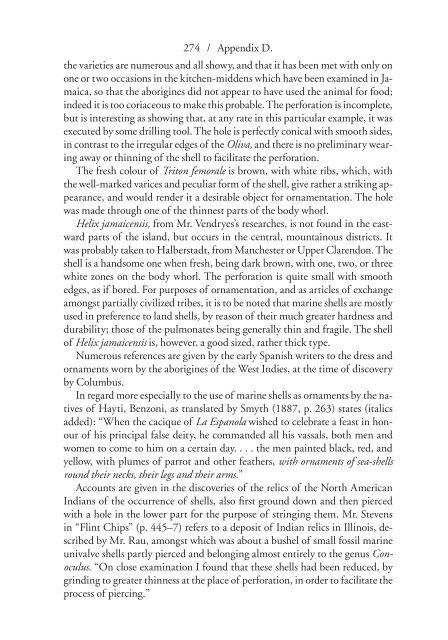Pre-Colombian Jamaica: Caribbean Archeology and Ethnohistory
by Phillip Allsworth-Jones
by Phillip Allsworth-Jones
You also want an ePaper? Increase the reach of your titles
YUMPU automatically turns print PDFs into web optimized ePapers that Google loves.
274 / Appendix D.<br />
the varieties are numerous <strong>and</strong> all showy, <strong>and</strong> that it has been met with only on<br />
one or two occasions in the kitchen- middens which have been examined in <strong>Jamaica</strong>,<br />
so that the aborigines did not appear to have used the animal for food;<br />
indeed it is too coriaceous to make this probable. The perforation is incomplete,<br />
but is interesting as showing that, at any rate in this particular example, it was<br />
executed by some drilling tool. The hole is perfectly conical with smooth sides,<br />
in contrast to the irregular edges of the Oliva, <strong>and</strong> there is no preliminary wearing<br />
away or thinning of the shell to facilitate the perforation.<br />
The fresh colour of Triton femorale is brown, with white ribs, which, with<br />
the well- marked varices <strong>and</strong> peculiar form of the shell, give rather a striking appearance,<br />
<strong>and</strong> would render it a desirable object for ornamentation. The hole<br />
was made through one of the thinnest parts of the body whorl.<br />
Helix jamaicensis, from Mr. Vendryes’s researches, is not found in the eastward<br />
parts of the isl<strong>and</strong>, but occurs in the central, mountainous districts. It<br />
was probably taken to Halberstadt, from Manchester or Upper Clarendon. The<br />
shell is a h<strong>and</strong>some one when fresh, being dark brown, with one, two, or three<br />
white zones on the body whorl. The perforation is quite small with smooth<br />
edges, as if bored. For purposes of ornamentation, <strong>and</strong> as articles of exchange<br />
amongst partially civilized tribes, it is to be noted that marine shells are mostly<br />
used in preference to l<strong>and</strong> shells, by reason of their much greater hardness <strong>and</strong><br />
durability; those of the pulmonates being generally thin <strong>and</strong> fragile. The shell<br />
of Helix jamaicensis is, however, a good sized, rather thick type.<br />
Numerous references are given by the early Spanish writers to the dress <strong>and</strong><br />
ornaments worn by the aborigines of the West Indies, at the time of discovery<br />
by Columbus.<br />
In regard more especially to the use of marine shells as ornaments by the natives<br />
of Hayti, Benzoni, as translated by Smyth (1887, p. 263) states (italics<br />
added): “When the cacique of La Espanola wished to celebrate a feast in honour<br />
of his principal false deity, he comm<strong>and</strong>ed all his vassals, both men <strong>and</strong><br />
women to come to him on a certain day. . . . the men painted black, red, <strong>and</strong><br />
yellow, with plumes of parrot <strong>and</strong> other feathers, with ornaments of sea- shells<br />
round their necks, their legs <strong>and</strong> their arms.”<br />
Accounts are given in the discoveries of the relics of the North American<br />
Indians of the occurrence of shells, also first ground down <strong>and</strong> then pierced<br />
with a hole in the lower part for the purpose of stringing them. Mr. Stevens<br />
in “Flint Chips” (p. 445–7) refers to a deposit of Indian relics in Illinois, described<br />
by Mr. Rau, amongst which was about a bushel of small fossil marine<br />
univalve shells partly pierced <strong>and</strong> belonging almost entirely to the genus Conoculus.<br />
“On close examination I found that these shells had been reduced, by<br />
grinding to greater thinness at the place of perforation, in order to facilitate the<br />
process of piercing.”


















